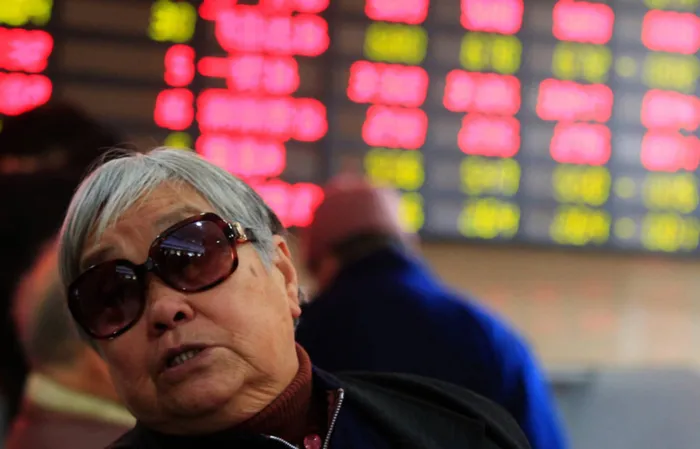China’s market rescue makes things worse

Picture: AP Photo. Picture: AP Photo.
What’s a Chinese company worth?
That’s always been a difficult question in a country where individual investors drive more than 80 percent of trades on local stock exchanges. Now, though, finding the answer has become harder than ever.
Between unprecedented government intervention to prop up the $6.5 equity trillion market and trading suspensions in more than 1 300 companies, analysts can no longer rely on share prices as an indicator of corporate value in the world’s second-largest economy.
The remarkable turn of events comes less than two years after China’s ruling Communist Party vowed to give market forces a bigger role in the economy, part of its largest reform drive since the 1990s. While the stock-market rescue mission is designed to stem a rout that erased $3.2 trillion in three weeks, it may end up making matters worse.
Traders rushed to sell whatever the could on Wednesday and foreign investors extended a record three-day exodus as the Shanghai Composite Index sank 3.9 percent in early trading.
“The market has failed,” said Hao Hong, a China strategist at Bocom International Holdings Co. in Hong Kong. “It’s distorted because we keep changing the rules as we play the game.”
As the Shanghai Composite’s record-breaking boom goes bust, President Xi Jinping’s government is deploying the heavy hand of the state in an attempt to prevent falling stock prices from eroding confidence in his leadership. China now has more than 90 million individual investors, a constituency that’s larger than the Communist Party.
State Support
Chinese authorities have suspended initial public offerings, restricted bearish bets via stock-index futures, encouraged financial firms to buy shares and ordered state-run companies to maintain holdings in listed units. In perhaps the most dramatic effort to prevent investors from selling, Chinese exchanges allowed at least 1 323 companies to halt trading in their shares.
“It’s absurd,” said Tsutomu Yamada, a market analyst at Kabu.com Securities in Tokyo. “It shows how much of a fake market it is. Those who want to sell will keep wanting to sell. When they start trading again, just think of how much selling there will be.”
The government’s market meddling is pushing historical price relationships to extreme levels.
Futures Gap
China’s CSI 300 Index futures, among the most-heavily traded contracts in the world, fell to a record discount versus the underlying equity gauge in late trading on Tuesday. It’s a sign that derivatives traders view share prices as artificially high after the trading suspensions and state efforts to prop them up, according to Jasper Lawler, a London-based analyst at CMC Markets.
PetroChina, which has traded in line with the broader Chinese market for much of its history, is now leading a surge among the biggest government-run companies even as the Shanghai Composite falls. The divergence, cause by a flood of buy orders from state-directed funds, turned PetroChina into the world’s second-largest company by market value on Tuesday.
The distortions may be spilling over into Hong Kong’s market as investors sell holdings as a way to hedge positions on the mainland, said Tony Chu, a Hong Kong-based money manager at RS Investment Management, which oversees more than $20 billion. Price gaps between dual-listed shares in Shanghai and Hong Kong, where international investors dominate trading, are the widest since 2009.
“The major problem is that government intervention is clearly doing more negative than good,” Chu said. “There’s really panic out there.”
Intervention Risk
Of course, China isn’t the only market with a history of state intervention. During the Asian financial crisis in 1998, Hong Kong’s government bought shares worth $15 billion to prop up the market. In the US, the Securities and Exchange Commission temporarily banned short selling on some shares during the global financial crisis in 2008.
“This is a risk you have to bear in mind,” said Wilfred Sit, the Hong Kong-based chief investment officer for Asia at Baring Asset Management.
Goldman Sachs Group Inc. says the barrage of market-supporting measures will work. Kinger Lau, the bank’s China strategist in Hong Kong, predicts the large-cap CSI 300 Index will rally 27 percent over the next 12 months as investor confidence improves and monetary easing spurs economic growth.
Margin Trades
“I compare the Chinese share market to a baby that’s learning to walk,” said Nader Naeimi, a money manager at AMP Capital in Sydney. “There will always be a parent picking up the baby after a fall.”
The government’s measures are unlikely to succeed in the short term because investor psychology is still too fragile, Mark McFarland, the chief global economist at Coutts & Co in Hong Kong, said in an interview on Bloomberg Television.
While Chinese investors are “relatively optimistic” about the future, they still want to reduce stakes, according to a poll by the Survey and Research Center for China Household Finance at Southwestern University of Finance and Economics. Only 40.5 percent of households still had gains in their stock accounts in the week starting June 27, down from 73.8 percent in the period June 15 to June 18, it found.
Margin traders, who fuelled the Shanghai Composite’s 150 percent rally in the year through June 12 with a five-fold surge in leveraged wagers, have been unwinding those positions for a record 12 straight days as share prices tumble.
“A market led by leverage isn’t going to last very long,” Andy Xie, an independent economist who previously worked for the World Bank and Morgan Stanley, said by phone from Hong Kong. “Unless fundamentals change, it’s all talk. None of these measures are going to work.”
Bloomberg